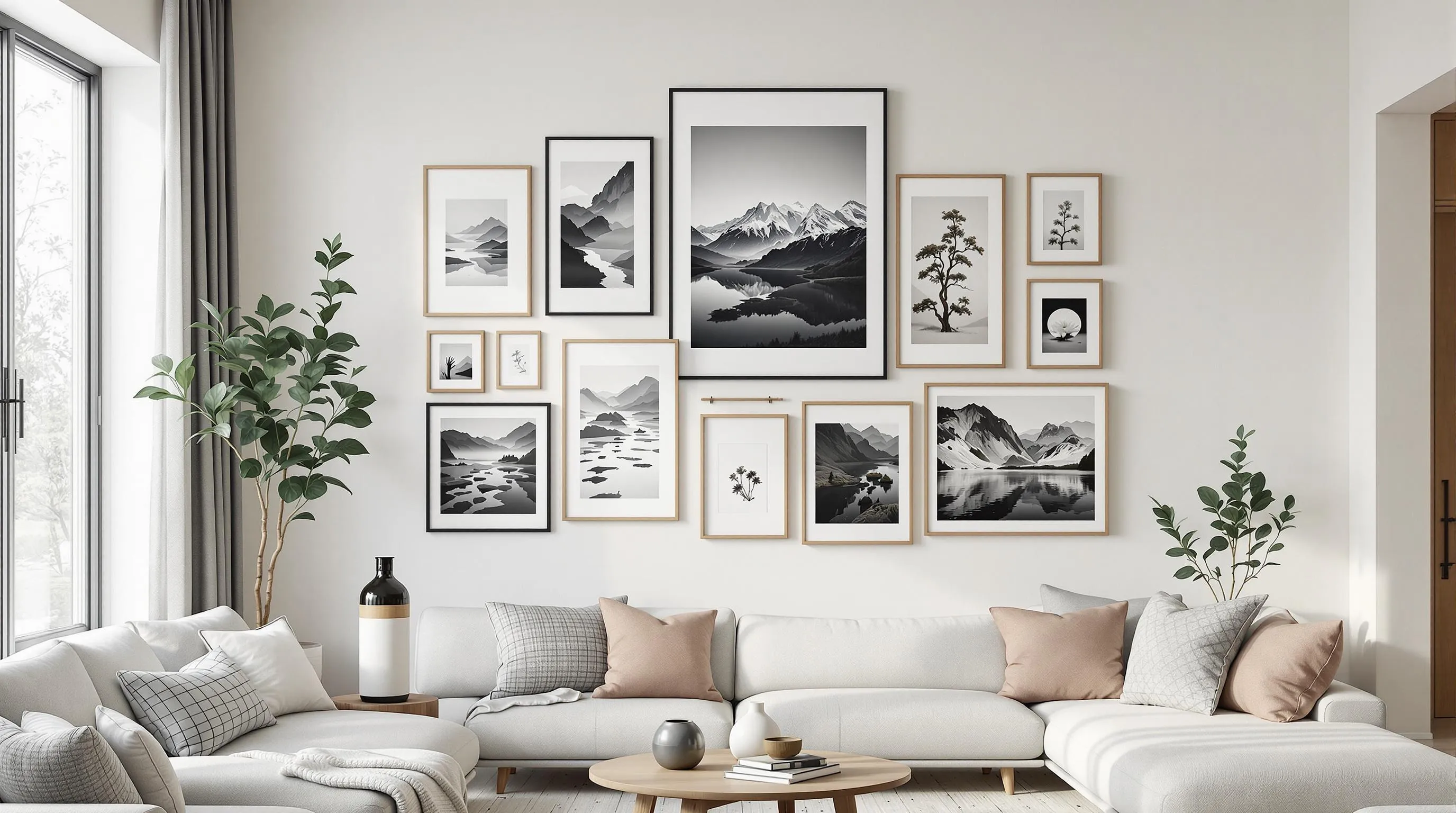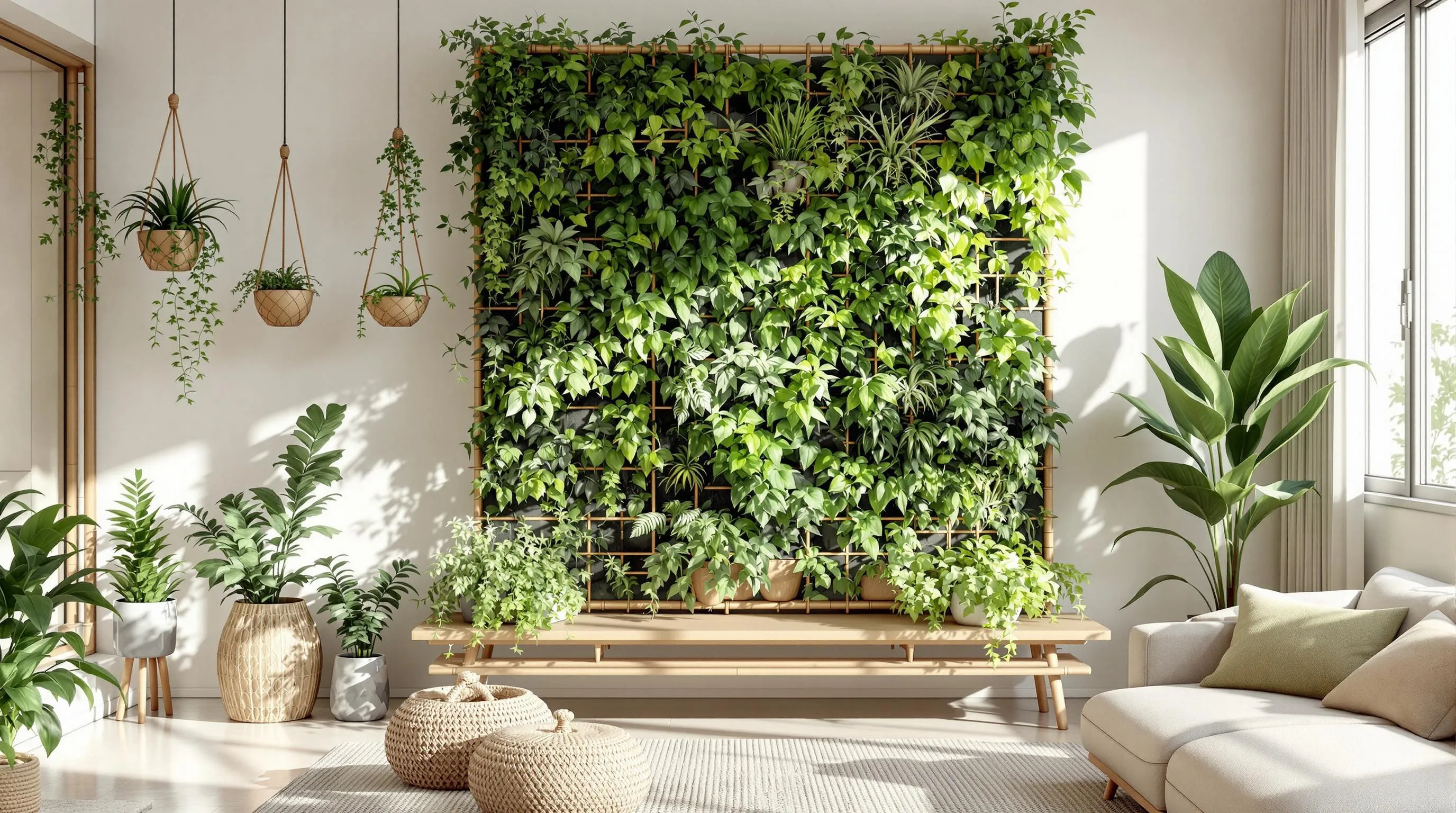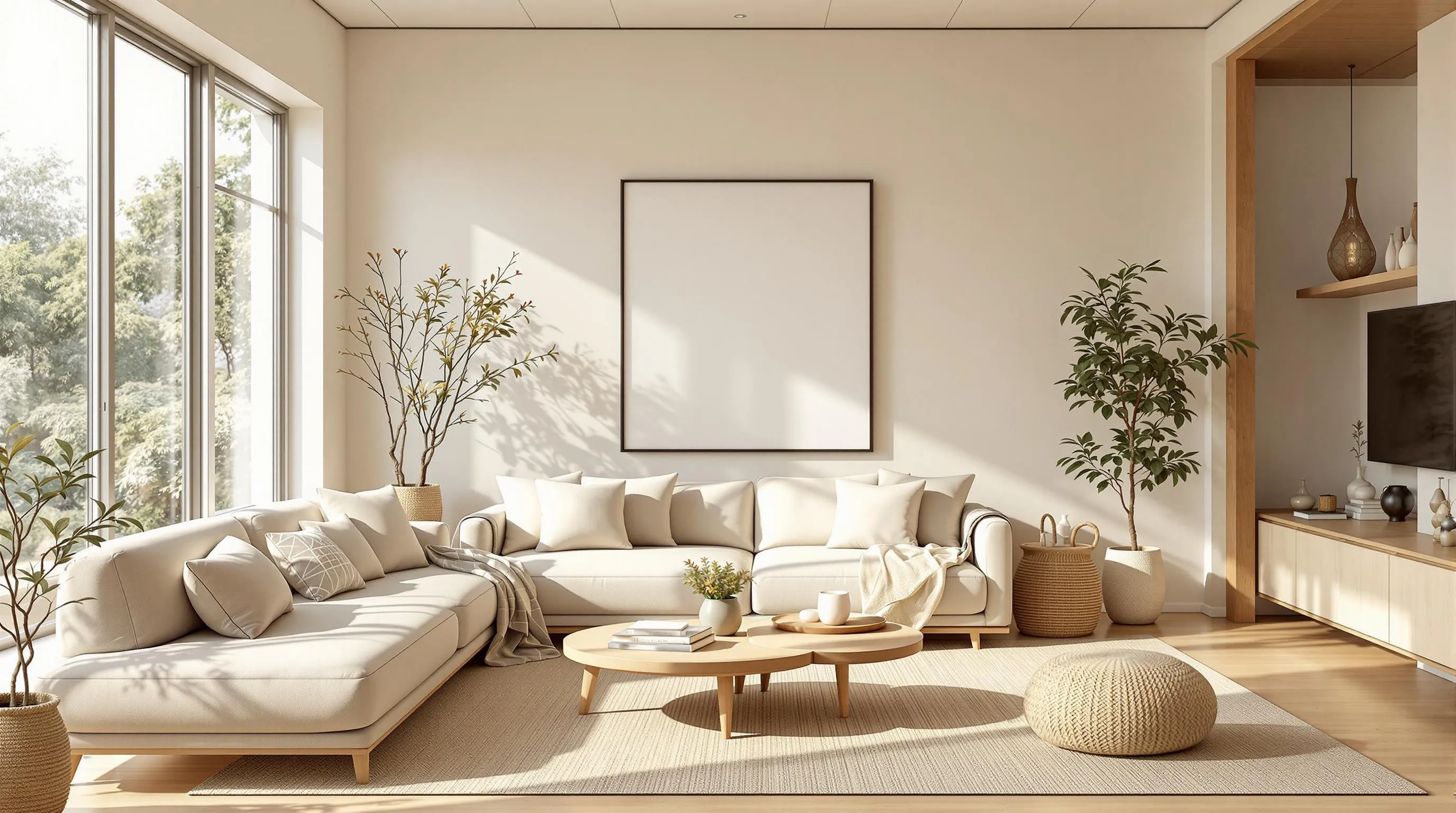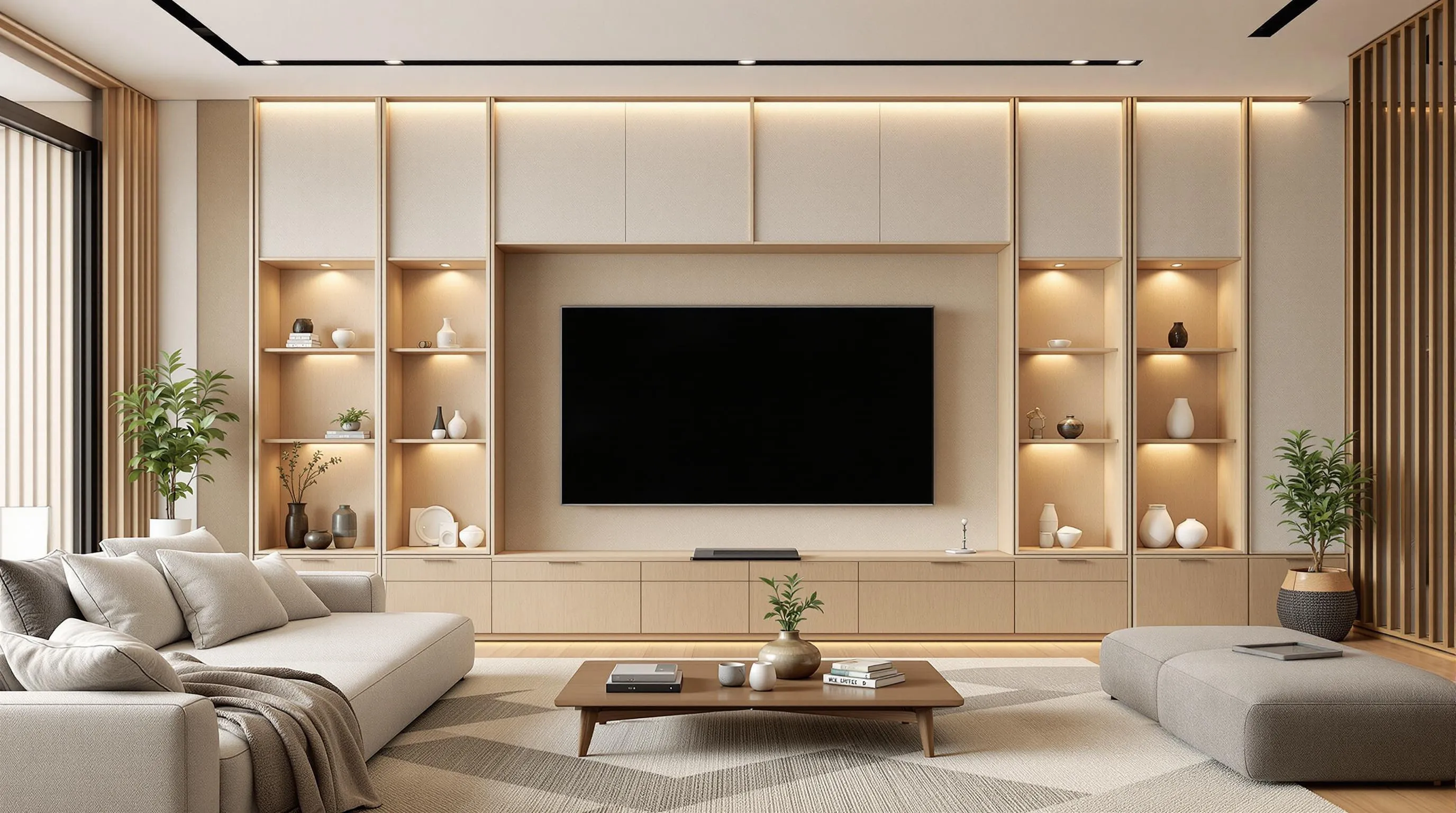We’ve all fallen in love with the serene beauty of Japandi design – that perfect marriage of Japanese minimalism and Scandinavian coziness that’s taking living rooms by storm. But here’s where many of us get stuck: creating walls that truly capture this harmonious aesthetic without overwhelming the space or very costly.
Your living room walls are the canvas for your Japandi transformation and we’re here to show you exactly how to get it right. From warm wood accents to strategic negative space these wall ideas will help you achieve that coveted balance between function and tranquility.
Whether you’re starting from scratch or looking to refresh your current space we’ll walk you through practical wall answers that embody Japandi’s core principles. Get ready to discover how the right wall treatments can transform your living room into a peaceful retreat that feels both modern and timeless.
Embrace Natural Wood Accent Walls for Authentic Japandi Appeal
Natural wood accent walls serve as the foundation for creating an authentic Japandi atmosphere in your living room. Wood brings warmth and organic texture that perfectly bridges Japanese minimalism with Scandinavian comfort.
Choose Light-Toned Woods Like Birch or Pine
Light-toned woods create the perfect backdrop for Japandi living rooms without overwhelming the space. Birch offers a smooth grain pattern with subtle pink undertones that complement neutral color palettes beautifully. Pine provides a more pronounced grain structure while maintaining the bright, airy feel essential to this design style.
We recommend selecting woods with minimal knots and consistent coloring to maintain the clean aesthetic. Oak in lighter finishes also works well, though it carries more visual weight than birch or pine. Maple delivers exceptional smoothness and takes stains evenly if you want to adjust the tone slightly.
Consider the room’s natural light when choosing your wood tone. North-facing rooms benefit from warmer woods like pine, while south-facing spaces can handle cooler tones like birch without feeling stark.
Install Vertical Wood Planks for Height Enhancement
Vertical wood planks elongate your living room walls and create the illusion of higher ceilings. Install planks in varying widths between 3 to 6 inches to add subtle visual interest without disrupting the minimalist principle. Running planks from floor to ceiling creates an unbroken line that maximizes the height effect.
Space planks with thin reveals of approximately 1/4 inch to maintain the clean Japandi aesthetic. We suggest using a consistent reveal width throughout the installation for visual harmony. Mount planks directly to wall studs or over a level substrate to ensure perfect alignment.
Floating installation methods work particularly well for rental properties or temporary design changes. These systems allow you to achieve the same visual impact without permanent wall modifications.
Consider Reclaimed Wood for Sustainable Design
Reclaimed wood adds character while supporting sustainable design principles central to Japandi philosophy. Barn wood, old fence panels, and salvaged flooring provide unique grain patterns and subtle weathering that new lumber cannot replicate. These materials often cost 20 to 30 percent less than new hardwood while offering superior character.
We recommend sanding reclaimed wood to a consistent finish while preserving natural imperfections that add visual interest. Apply a clear protective finish to enhance the wood’s natural color and protect against moisture. Choose pieces with similar thickness to ensure proper installation and a professional appearance.
Source reclaimed materials from local suppliers to reduce transportation costs and environmental impact. Many reclamation yards offer pre-processed planks ready for installation, saving you preparation time while maintaining authenticity.
Create Minimalist Gallery Walls with Carefully Curated Art

Gallery walls in Japandi design require thoughtful curation rather than extensive collections. We focus on selecting fewer pieces that create maximum visual impact while maintaining the serene atmosphere essential to this aesthetic.
Select Black and White Photography
Black and white photography serves as the cornerstone of Japandi gallery walls because it aligns perfectly with neutral color palettes. We recommend choosing photographs that feature natural subjects like landscapes, architectural details, or abstract compositions that emphasize light and shadow. These monochromatic images add sophistication without introducing competing colors that might disrupt the room’s harmony.
Photography prints work exceptionally well when they showcase clean lines and geometric patterns. We suggest limiting your selection to three to five pieces maximum to prevent visual overwhelm. Large format prints create more impact than multiple small images, allowing each photograph to breathe within the space.
Display Traditional Japanese Prints
Traditional Japanese prints bring cultural authenticity to Japandi living rooms while honoring the style’s heritage. We particularly value woodblock prints (ukiyo-e) that feature simple botanical motifs, mountain scenes, or minimalist wave patterns. These artworks connect the space to Japanese artistic traditions without appearing cluttered or busy.
Vintage or reproduction prints of famous works by artists like Hokusai or Hiroshige can serve as focal points for your gallery wall. We recommend selecting prints that use muted colors or stick to black ink on natural paper to maintain color consistency. Single large prints often work better than collections of smaller pieces in maintaining the minimalist aesthetic.
Frame Artwork in Natural Wood or Black Frames
Natural wood frames enhance the organic elements already present in Japandi design through your wood accent walls. We prefer light woods like oak, birch, or maple that complement rather than compete with wall treatments. These frames create seamless integration between your artwork and the room’s existing materials.
Black frames offer a contemporary alternative that provides crisp contrast against neutral walls. We use thin profile frames to maintain the minimalist approach rather than heavy, ornate options that would overwhelm the space. Consistent framing across all pieces creates cohesion, whether you choose all wood, all black, or alternate between the two in a deliberate pattern.
Install Floating Shelves for Functional Wall Storage

Floating shelves transform Japandi living room walls by combining practical storage with elegant minimalist design. They optimize vertical space while maintaining the clean aesthetic that defines this harmonious style.
Use Light Wood Shelving Materials
Light wood shelving materials serve as the foundation for authentic Japandi wall storage. We recommend selecting pale oak, birch, or pine shelves that blend seamlessly with neutral color palettes while adding natural warmth to your living space. These wood tones create visual continuity with other organic elements in the room without overwhelming the minimalist aesthetic.
Mounting these shelves at varying heights creates visual interest while maintaining the uncluttered appearance essential to Japandi design. The natural grain patterns in light woods provide subtle texture that enhances the room’s organic feel. Quality hardwood shelves ensure durability while supporting the sustainable design principles central to both Japanese and Scandinavian philosophies.
Display Ceramics and Natural Objects
Ceramics and natural objects on floating shelves add depth and visual interest to Japandi living room walls. We suggest curating collections of handmade pottery, smooth river stones, or dried botanicals that reflect the style’s connection to nature. These items should vary in height and texture while maintaining a cohesive neutral color scheme.
Positioning ceramic vases with clean lines alongside natural wood objects creates pleasing contrasts that draw the eye without creating chaos. Small potted plants or single stems in simple vessels bring life to the shelving display while reinforcing the nature inspired elements of Japandi design. Each object should serve either a functional purpose or contribute to the room’s serene atmosphere.
Maintain Clean Lines and Minimal Clutter
Clean lines and minimal clutter define successful Japandi floating shelf installations. We emphasize spacing items generously to allow each piece room to breathe and be appreciated individually. This approach prevents the shelves from becoming overwhelming focal points that disrupt the room’s peaceful energy.
Limiting displays to three to five carefully chosen items per shelf maintains the minimalist essence while creating visual balance. Regular editing of shelf contents ensures that only meaningful objects remain on display. The negative space between items becomes as important as the objects themselves in creating the contemplative atmosphere that makes Japandi living rooms so appealing.
Add Textural Interest with Natural Fiber Wall Hangings

Natural fiber wall hangings offer the perfect solution for adding organic texture to our Japandi living room walls while maintaining the serene, uncluttered aesthetic we’ve been building. These textile elements introduce subtle visual warmth without disrupting the harmonious balance between Japanese minimalism and Scandinavian comfort.
Incorporate Woven Jute or Hemp Tapestries
Woven jute tapestries provide an instant dose of organic texture that complements the natural wood elements we’ve already established in our living room. These natural fiber pieces create visual warmth while preserving the clutter-free environment essential to Japandi design. Hemp tapestries offer similar benefits with their earthy textures and sustainable origins, making them ideal choices for our eco-conscious design approach.
Select tapestries with simple geometric patterns or subtle abstract designs that won’t compete with our minimalist gallery walls or floating shelves. Mount these pieces at eye level using discrete wooden hanging systems that blend seamlessly with our natural material palette. Consider choosing tapestries in neutral tones like warm beiges, soft grays, or muted browns to maintain the calm color scheme we’ve been developing throughout our space.
Display Macrame Wall Art in Neutral Tones
Macrame wall art in soft grays reinforces our soothing atmosphere while adding dimensional interest to previously flat wall surfaces. These handcrafted pieces work particularly well when positioned near our floating shelves, creating a layered look that maintains visual balance. Earthy brown macrame designs complement the warm wood accents we’ve incorporated, while pale blue pieces can introduce subtle color variation without disrupting our muted palette.
Choose macrame pieces with clean, simple designs rather than overly complex patterns that might feel too busy for our Japandi aesthetic. Hang these artworks using natural rope or wooden dowels to maintain consistency with our material choices. Position macrame art strategically to create visual triangles with our other wall elements, ensuring each piece has adequate breathing room to prevent the space from feeling cluttered.
Choose Handcrafted Textile Pieces
Handcrafted textile pieces featuring minimalist patterns bring cultural authenticity to our Japandi living room without overwhelming the space. These artworks often incorporate abstract shapes inspired by nature, reinforcing the connection to organic elements we’ve established through our wood accents and natural displays. Select pieces that showcase traditional craftsmanship while maintaining the restraint essential to our design philosophy.
Focus on textiles with subtle textures and muted colors that enhance rather than dominate our wall composition. Consider pieces featuring simple line work, gentle curves, or nature-inspired motifs like branches or stones. Frame textile artworks in natural wood or bamboo to create cohesion with our existing elements, ensuring each piece contributes to the overall sense of tranquility and balance we’re cultivating in our living space.
Design Feature Walls with Natural Stone or Brick

Natural stone and brick elements introduce authentic texture while maintaining the serene balance essential to Japandi design. These materials create visual anchors that ground your living space without disrupting the minimalist aesthetic.
Expose Existing Brick for Industrial Touch
Exposed brick walls bring an industrial edge that perfectly complements Japandi’s clean lines and natural materials. The raw, unpolished texture creates striking contrast against smooth wood furnishings and neutral fabrics. We love how authentic brick surfaces add earthy character while preserving the minimalist framework that defines this design style.
Industrial elements work beautifully when balanced with softer textures like linen cushions and natural fiber rugs. Brick’s natural reddish tones provide warmth without overwhelming the space’s tranquil atmosphere. The weathered appearance tells a story while supporting the Japandi principle of embracing imperfection and natural aging.
Install Natural Stone Veneer Panels
Stone veneer panels offer a lightweight solution for creating stunning feature walls with minimal structural impact. These modern alternatives deliver the visual appeal and texture of natural stone while maintaining easy installation. We recommend choosing panels in light limestone or pale sandstone to keep your living room feeling airy and spacious.
Veneer systems provide consistent patterns and colors that enhance tranquility without creating visual chaos. The subtle variations in natural stone add depth while supporting the Japandi emphasis on organic materials. Installation costs remain lower than solid stone, making this approach accessible for budget conscious homeowners seeking authentic textures.
Paint Brick Walls in Soft White or Cream
Painting existing brick in soft white or cream tones preserves texture while brightening your living space significantly. This technique softens industrial features and creates seamless integration with Japandi’s neutral color schemes. We find that painted brick maintains visual interest through its dimensional surface while supporting the calm, uncluttered aesthetic.
Soft white paint allows natural light to reflect throughout the room, improving the sense of spaciousness essential to minimalist design. Cream tones add subtle warmth that complements natural wood elements and neutral furnishings. The painted surface becomes a cohesive backdrop that highlights clean lines and functional furniture pieces without competing for attention.
Incorporate Living Walls with Indoor Plants

Living walls transform bare surfaces into stunning natural features that perfectly embody Japandi design principles. We can enhance our serene living spaces by integrating vertical greenery that maintains the minimalist aesthetic while adding essential natural elements.
Mount Vertical Garden Systems
Vertical garden systems offer the most efficient way to create lush living walls without overwhelming our Japandi spaces. These modular systems allow us to customize plant arrangements while ensuring easy maintenance access. We recommend choosing systems with clean lines and natural materials like bamboo or untreated wood frames.
Installing these systems requires minimal wall modification and provides maximum visual impact. The structured format helps maintain organization while supporting various plant types from trailing pothos to compact ferns. We can adjust plant placement seasonally to keep our living walls fresh and ever-changing.
Maintenance becomes simplified when we select systems with built-in irrigation features. These automated watering answers prevent overwatering while ensuring consistent moisture levels for optimal plant health. The result creates a stunning backdrop that enhances our room’s tranquil atmosphere.
Display Air Plants on Wall-Mounted Holders
Air plants bring unique sculptural qualities to our Japandi walls without requiring soil or complex care routines. These remarkable plants absorb moisture and nutrients directly from the air through their specialized leaves. We can mount them using minimalist holders crafted from natural wood or simple metal brackets.
Geometric holders complement the clean lines essential to Japandi design while showcasing each plant’s distinctive form. The holders should feature neutral tones that blend seamlessly with our existing color palette. We recommend spacing multiple air plants at varying heights to create visual rhythm without cluttering the wall space.
These low-maintenance plants thrive in bright, indirect light and need only weekly misting to flourish. Their silvery-green foliage adds textural interest while maintaining the serene quality we value in Japandi interiors. The absence of soil eliminates mess and supports our preference for clean, uncluttered surfaces.
Create Hanging Plant Arrangements
Hanging planters introduce graceful movement to our living walls while preserving floor space essential to Japandi functionality. We can suspend plants at different heights using natural rope or minimalist metal chains that complement our room’s aesthetic. This approach creates layered visual interest without overwhelming the space.
Selecting the right planters enhances our design goals while supporting healthy plant growth. Ceramic vessels in neutral tones or natural fiber baskets work beautifully within Japandi schemes. We should choose planters with proper drainage to prevent water damage to our walls and flooring.
Plant selection becomes crucial for successful hanging arrangements in our Japandi living rooms. Trailing varieties like string of hearts or spider plants add gentle movement while maintaining the peaceful atmosphere we desire. These arrangements can be repositioned easily to accommodate changing light conditions or seasonal preferences.
Use Neutral Paint Colors for Serene Wall Backgrounds

Neutral paint colors form the foundation of any successful Japandi living room design. We recommend these calming tones to create the perfect backdrop for your minimalist sanctuary.
Apply Warm White and Cream Tones
Warm white paints instantly brighten our living rooms while maintaining the cozy atmosphere essential to Japandi design. These inviting hues reflect natural light throughout the space, making smaller rooms feel more expansive and airy. Cream tones add subtle warmth that prevents our walls from feeling cold or sterile, creating welcoming environments that support both relaxation and daily activities.
Paint selections like soft ivory or antique white work exceptionally well with natural wood furniture and organic textiles. We find these colors enhance the minimalist feel while keeping spaces comfortable for family gatherings. Warm undertones in these paints complement both natural and artificial lighting, ensuring our living rooms remain inviting throughout different times of day.
Choose Soft Beige and Taupe Shades
Soft beige brings gentle earthiness to our Japandi living room walls without overwhelming the minimalist aesthetic. These natural hues pair beautifully with wooden accents and linen textiles, reinforcing our connection to organic materials. Taupe shades offer sophisticated depth while maintaining the calm atmosphere we seek in our peaceful retreats.
Beige tones create seamless transitions between our walls and natural wood elements like floating shelves or accent panels. We appreciate how these colors support the Japandi emphasis on harmony between different materials. Taupe variations work particularly well in larger living rooms where we want to add visual interest without introducing bold patterns or bright colors.
Consider Matte Paint Finishes for Depth
Matte finishes absorb light rather than reflecting it, reducing glare and contributing to the quiet ambiance we desire in our Japandi spaces. These non-reflective surfaces add subtle texture and visual depth to our walls without requiring additional decorative elements. Matte paints help us achieve the understated elegance that defines successful Japandi interiors.
Paint sheens like eggshell or flat create sophisticated wall surfaces that don’t compete with our carefully curated furniture and decor. We find matte finishes particularly effective in living rooms with large windows, as they prevent harsh reflections that can disrupt the serene atmosphere. These paint choices allow our natural materials and minimal artwork to take center stage while providing a beautiful, unobtrusive backdrop.
Install Japanese-Inspired Architectural Elements

Traditional Japanese design elements bring authentic cultural depth to our Japandi living room walls. These architectural features create functional beauty while maintaining the clean aesthetic we’ve established through our previous wall treatments.
Add Shoji Screen Panels as Room Dividers
Shoji screens transform our living spaces by creating gentle separation without blocking natural light flow. These translucent paper or glass panels mounted in wooden frames maintain the open feel essential to Japandi design while defining distinct areas within our room.
We can position shoji screens to separate seating areas from dining spaces or create a quiet reading nook. The screens’ ability to filter light creates soft shadows that enhance our neutral color palette and complement the natural wood accents we’ve already incorporated.
Installation requires mounting tracks on our ceiling or floor for sliding movement. Traditional shoji screens feature rice paper panels that diffuse light beautifully, though modern versions use frosted glass for durability in high-traffic living rooms.
Incorporate Sliding Wall Panels
Sliding panels offer flexibility while hiding storage answers that support our clutter-free environment. These wall-mounted systems can conceal entertainment centers, bookshelves, or home office areas when we need to maintain our minimalist aesthetic.
We recommend installing sliding panels made from light wood like birch or pine to match our existing accent walls. The panels glide smoothly on hidden tracks, allowing us to transform our space instantly for different activities or when entertaining guests.
Custom sizing ensures these panels integrate seamlessly with our room’s proportions. Many sliding wall systems feature soft-close mechanisms that operate silently, preserving the tranquil atmosphere we’ve created through our plant displays and neutral paint choices.
Install Recessed Wall Niches for Display
Recessed niches create sophisticated display spaces that maintain our walls’ clean lines while showcasing carefully chosen decorative objects. These built-in features eliminate the need for additional furniture while providing perfect spots for our ceramics, small plants, or minimal art pieces.
We can design niches in various sizes to accommodate different objects from our curated collection. Shallow recesses work beautifully for displaying single pottery pieces or air plants, while deeper niches can house small sculptures or books arranged with intentional spacing.
Proper lighting transforms these niches into focal points that enhance our gallery wall arrangements. LED strip lighting installed within each recess creates gentle illumination that highlights textures and maintains the warm atmosphere we’ve established through our natural materials and matte paint finishes.
Conclusion
Creating the perfect Japandi living room walls isn’t about following rigid rules—it’s about finding balance between function and beauty. We’ve shown you how simple elements like natural wood accents neutral paint colors and thoughtful plant displays can transform any space into a peaceful retreat.
The key lies in choosing quality over quantity and letting each element breathe. Whether you’re drawn to exposed brick textures shoji screen panels or minimalist gallery arrangements remember that authentic Japandi design celebrates imperfection and natural materials.
Start with one wall treatment that speaks to you and build from there. Your living room should reflect your personal journey toward creating a harmonious home that nurtures both body and mind.
Frequently Asked Questions
What is Japandi design style?
Japandi design combines Japanese minimalism with Scandinavian coziness, creating a harmonious aesthetic that emphasizes natural materials, neutral colors, and functional simplicity. This style focuses on creating peaceful, uncluttered spaces that connect you with nature while maintaining warmth and comfort in your living environment.
What are the best wood types for Japandi accent walls?
Light-toned woods like birch, pine, and oak work best for Japandi accent walls. These woods provide warmth and organic texture while maintaining the minimalist aesthetic. Reclaimed wood is also excellent as it supports sustainable design principles and adds unique character to your space.
How do I create a minimalist gallery wall in Japandi style?
Focus on thoughtful curation over extensive collections. Select fewer pieces like black and white photography or traditional Japanese woodblock prints. Use natural wood or black frames, and maintain plenty of negative space between artworks to preserve the clean, uncluttered aesthetic essential to Japandi design.
What paint colors work best for Japandi living rooms?
Choose neutral paint colors like warm whites, cream tones, soft beige, and taupe shades. These colors create serene backgrounds while maintaining coziness. Opt for matte paint finishes as they absorb light and add subtle texture, contributing to the understated elegance of Japandi interiors.
How can I incorporate plants into Japandi wall design?
Create living walls using vertical garden systems made from natural materials like bamboo. Display air plants in minimalist holders for sculptural qualities, or arrange hanging plants to add movement while preserving floor space. Choose plants that enhance tranquility and maintain the clean aesthetic.
What are shoji screens and how do they fit Japandi design?
Shoji screens are traditional Japanese sliding panels made with translucent paper and wooden frames. They create gentle room separations without blocking natural light, perfectly embodying Japandi principles. Use them as room dividers or wall panels to add authentic Japanese architectural elements while maintaining functionality.
Can I use brick walls in Japandi design?
Yes, exposed brick walls can work in Japandi design when done thoughtfully. They add warmth and texture without overwhelming the minimalist framework. Consider painting existing brick in soft white or cream tones to preserve texture while brightening the space and maintaining the serene balance.
What types of wall hangings suit Japandi style?
Choose natural fiber wall hangings like woven jute or hemp tapestries with simple geometric patterns in neutral tones. These add textural interest while reinforcing the connection to nature. Avoid busy patterns or bright colors that would disrupt the harmonious, minimalist aesthetic.







